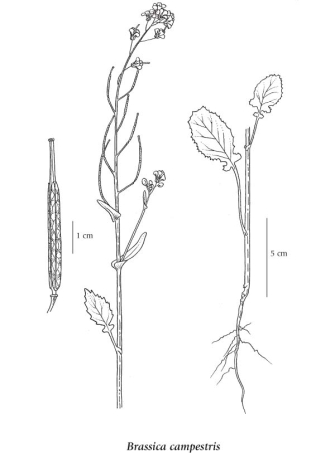Brassica rapa L.
field mustard (bird's rape)
Brassicaceae (Mustard family)
Introduction to Vascular Plants
field mustard (bird's rape)
Brassicaceae (Mustard family)
Introduction to Vascular Plants
Photograph
© Dave Ingram (Photo ID #19886)
Species Information
General:
Annual herb from a taproot; stems glabrous or sparsely hairy, glaucous, 20-40 cm tall, simple to freely branched.
Leaves:
Basal leaves slender-stalked, pinnately cleft with the terminal lobe the largest, 2-4 lateral lobes, the terminal lobe egg-shaped, wavy-toothed; lowermost stem leaves similar to the basal but ear-like at the bases and clasping or unstalked, upper oblong, narrowly egg-shaped or lanceolate, subentire.
Flowers:
In terminal clusters; flower stalks stout, ascending, 7-25 mm long; petals yellow, 6-8 mm long; sepals 3-4 mm long.
Fruits:
Siliques, ascending to spreading, 3-7 cm long, 2.5-3.5 mm wide, straight; styles beaked, 10-15 mm long; seeds 1.5 mm long, minutely honeycombed.
Illustration

If more than one illustration is available for a species (e.g., separate illustrations were provided for two subspecies) then links to the separate images will be provided below. Note that individual subspecies or varietal illustrations are not always available.
Illustration Source: The Illustrated Flora of British Columbia
USDA Species Characteristics
Blooming Period:
Late Spring
Fruit/Seed characteristics:
Colour: Brown
Present over the Summer
Source: The USDA
Habitat and Range
Mesic to dry roadsides, fields and waste places in the lowland, steppe and montane zones; frequent in BC S of 56degreeN; introduced from Eurasia.Status Information
Synonyms
Synonyms and Alternate Names:
Brassica campestris L.